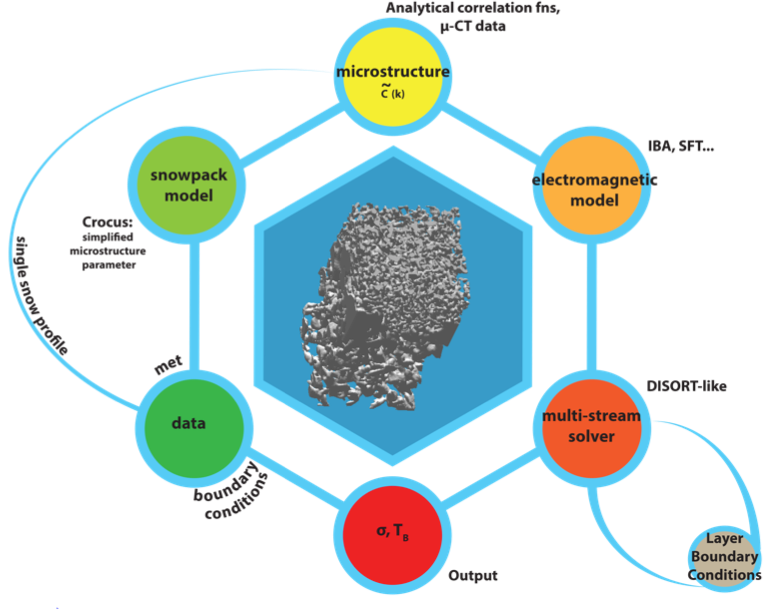Open-Source Models
 SMRT is a new generation microwave radiative transfer model to compute thermal emission and backscatter of snowpacks. Initiated in an ESA project on snow microstructure in 2015, it is nowaday a comprehensive framework to conduct simulations for a wide range of media and electromagnetic conditions. The model is highly modular allowing switching between different scattering theories, snow microstructure representation, ice permittivity formulations, radiative transfer solving methods, etc. The model is also highly extensible and fully open to community developments. The model is equipped with a rich ecosystem of tools and a comprehensive documentation to lower the learning barrier for beginners.
SMRT is a new generation microwave radiative transfer model to compute thermal emission and backscatter of snowpacks. Initiated in an ESA project on snow microstructure in 2015, it is nowaday a comprehensive framework to conduct simulations for a wide range of media and electromagnetic conditions. The model is highly modular allowing switching between different scattering theories, snow microstructure representation, ice permittivity formulations, radiative transfer solving methods, etc. The model is also highly extensible and fully open to community developments. The model is equipped with a rich ecosystem of tools and a comprehensive documentation to lower the learning barrier for beginners.
- DMRT-ML computes the thermal microwave emission of snowpacks, is now available as an open source software. It is based on the Dense Media Radiative Transfer theory. Unless you need the speed of Fortran, SMRT can do what DMRTML does, and much more, and much easier.
- TARTES computes snow albedo and other optical properties in the visible/near infrared range. It is a great small piece of Python code that merges Kokhanovsky and Zege, (2004) theory and two-stream solution of the radiative transfer equation. For this public release, we improved the model code and prepared a comprehensive documentation to make TARTES as easy-to-use as possible by any snow scientists with or without (strong) snow optics expertise.
- Snowoptics is a general purpose collection of Python functions to compute snow optical properties such as albedo or extinction for a semi-infinite snowpack on a flat or tilted surface. It also includes slope-effect correction function based on Picard et al. 2020.
- Minimal Firn Model (MFM) is a simple surface energy budget + thermal diffusion model to compute surface and internal temperature in the Antarctic and Arctic snowpack.
- Other models and tools: visit my github repositories.
 SMRT is a new generation microwave radiative transfer model to compute thermal emission and backscatter of snowpacks. Initiated in an ESA project on snow microstructure in 2015, it is nowaday a comprehensive framework to conduct simulations for a wide range of media and electromagnetic conditions. The model is highly modular allowing switching between different scattering theories, snow microstructure representation, ice permittivity formulations, radiative transfer solving methods, etc. The model is also highly extensible and fully open to community developments. The model is equipped with a rich ecosystem of tools and a comprehensive documentation to lower the learning barrier for beginners.
SMRT is a new generation microwave radiative transfer model to compute thermal emission and backscatter of snowpacks. Initiated in an ESA project on snow microstructure in 2015, it is nowaday a comprehensive framework to conduct simulations for a wide range of media and electromagnetic conditions. The model is highly modular allowing switching between different scattering theories, snow microstructure representation, ice permittivity formulations, radiative transfer solving methods, etc. The model is also highly extensible and fully open to community developments. The model is equipped with a rich ecosystem of tools and a comprehensive documentation to lower the learning barrier for beginners.